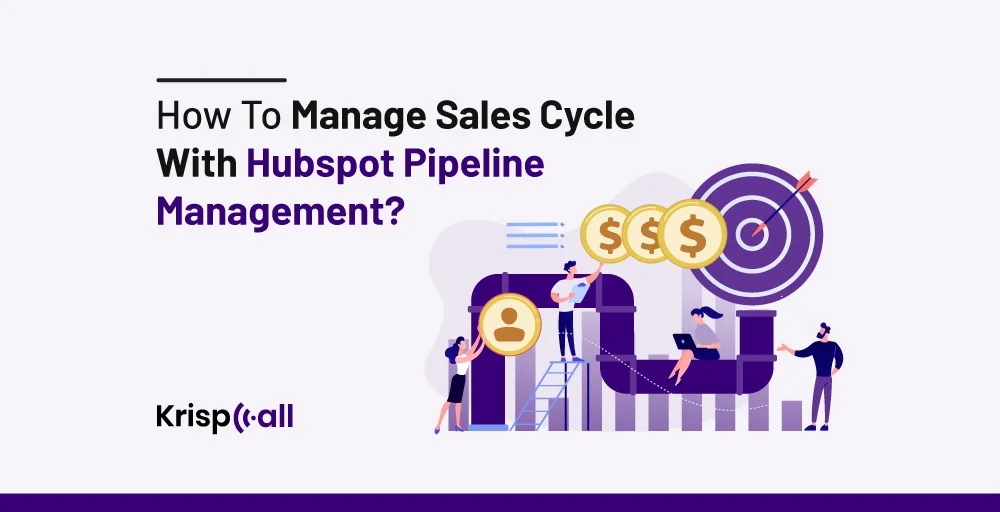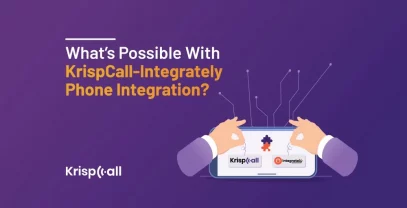For businesses, it is evident that effectively managing the sales cycle is essential for sustainable growth and success. And by managing it, we mean keeping a close eye on the nuts and bolts of their sales processes just to make sure they are not losing out on any opportunities.
While there are many powerful solutions that can streamline and optimize business sales processes, there’s one that stands as better than the rest — HubSpot’s Pipeline Management. It is a tool that offers a comprehensive suite of features designed to help businesses manage their sales pipelines more efficiently.
In this blog, we’ll describe what a sales pipeline is, why it’s important, what benefits it brings, how to build one for your business, and how to make it even better with better telephony management.
Let’s get going!
🔑 KEY HIGHLIGHTS
- A sales pipeline shows how a lead is moved toward a successful deal from the perspective of a sales representative.
- You need a sales pipeline to view the quantity of success, forecast potential revenue, and get a chance to evaluate your sales processes.
- HubSpot Pipeline Management Software helps businesses organize and track the complete sales cycle in one location.
- With HubSpot pipeline management software, you can visualize & streamline sales cycles, manage & customize deal stages, and customize customer data.
- With KrispCall and HubSpot integration, you make sales pipeline and telephony management more effective and convenient.
What Is a Sales Pipeline?
A Sales Pipeline is a system that offers an organized visual representation of the tracking sales process from the perspective of sales representatives and the way they can turn any leads into successful deals or customers.
The sales pipeline visually shows potential buyers as they progress into different stages, beginning with lead generation.
Importance Of a Sales Pipeline
Sales Representatives use sales pipelines to understand the stages of turning leads into transactions. Pipeline in sales planning is crucial in business and marketing. Find out its importance in the below section:
- Shows the Quantity of Success in Each Phase of Business Deals: Sales Pipeline helps you determine whether a sales representative reaches a lead client and if the client still needs to make their first order.
- Allow the Company to Forecast the Potential Revenue: A Sales Pipeline forecasts the possible revenue monthly, quarterly, semi-annually, or annually. It helps you identify your progress on reaching financial goals or the need to catch up and adjust marketing strategies.
- Clear Report on the Critical Financial Metrics in Business: The Sales pipeline offers a clear report on the critical financial metrics. Those metrics are essential to check if your business meets the revenue goals and if the profits are available.
- Present the Status and Accounts of Sales Representatives: Sales representatives are the frontline of the business, helping it reach its target market and new prospective clients. Therefore, you need to monitor their status and accounts, which can be done via the sales pipeline.
- Chance to Evaluate Sales Action as a Company: You can determine your business cycle’s weak and strong points through the sales pipeline. It lets you evaluate the actions that are suitable for specific stages in the business cycle that seem weak.
What is HubSpot Pipeline Management Software?
HubSpot Pipeline Management Software is a free software that helps businesses organize and track their complete sales cycle in one place. Using HubSpot Pipeline Management Software, you can help your teams understand how deals move from the initial contact to the closing sale.
You can set up the sales pipeline in HubSpot by following the steps below:
- Log into your HubSpot account.
- Click on Settings at the top of the navigation bar.
- Then, Navigate to Objects to Deals in the left sidebar menu.
- Click on the Select a Pipeline dropdown menu.
- Now, Select Create Pipeline.
Following those steps, you can set up the sales pipeline in HubSpot.
Benefits Of HubSpot Pipeline Management
HubSpot Pipeline Management guarantees you the opportunity to turn interest into a sale. HubSpot Pipeline Management provides several benefits, such as:
- Streamlined Sales Cycle: HubSpot Pipeline Management software lets you manage the entire sales cycle in a centralized place. It makes it easier to find roadblocks, track performance, and customize your sales process. The sales team can swiftly get the important data to interact with leads and close desks, minimizing the time and effort required to manage the sales cycle.
- Efficient Deals Management: HubSpot Pipeline Management software lets you add deals to the new pipeline, customize deal stages, and track progress toward the quota. A sales team can efficiently manage deals through a centralized location, allowing them to focus on engaging leads and closing deals.
- Visualizing Sales Funnel: The pipeline provides a visual representation of the sales funnel. This helps you secure more customers for your business and quickly determine any leaks. Businesses can also visualize the sales funnel to find areas that need improvement and optimize their sales process.
- Customizable Deal Stages: HubSport’s pipeline management software allows you to edit existing deal stages or add new ones. Therefore, it ensures that the pipeline aligns with your sales results and helps the sales team determine chances for improvement and optimize their sales.
- Centralized Customer Database: HubSpot offers a centralized customer database that lets businesses save all customer data in a single location. This ensures that everyone in the company collaborates well and has up-to-date information. It also saves customer service efforts, which increases customer satisfaction and loyalty.
How to Build a Sales Pipeline?
Several things need to be understood before building a sales pipeline. The understanding itself means a thorough knowledge of details about your target market, buyer personas, products and prices, and sales team is crucial.
That said, there are some crucial steps that you need to get over with, all of which are mentioned below:
- Qualify your leads: If it’s about sales, that means you’ve got leads. When thinking about building a pipeline, firstly, the only thing to do is look for prospects who match your ideal customer profile. There are various techniques like content marketing, social media outreach, or cold calling that you can use just in this step.
- Identify pipeline stages: Once you’ve got your leads, you need to set a strategy to stage everything. This is needed as it will reflect the way a prospect goes through before becoming a customer. Some typical stages are lead generation, qualification, contacting the lead, proposal, negotiation, closing, and onboarding.
- Define activities at different stages: As the next step, you must remember that each stage in your pipeline will have individual workflows that convert prospects into leads. So here, you need to define the activities you need to execute for each of those. The activities may include conducting prospecting research, sending follow-up emails, and cold calling.
- Estimate pipeline size: Also, you must find out, ‘estimate,’ how many opportunities you need in your pipeline to hit your quota or close a deal. There are many things that you can do here, but an easy one is using a good CRM tool to analyze the different sales stages and keep an eye on pipeline size.
- Set up and monitor metrics: As a key step, you must dive into tracking and monitoring key metrics like conversion rates, win rates, and sales velocity to measure the effectiveness of your pipeline. After all, a healthy pipeline is a happy pipeline (and a happy C-suite.
What are The Different Stages Of The HubSpot Sales Pipeline?
Knowing how to build a HubSpot sales pipeline is one thing; actually, creating one is an entirely different matter. So, what makes it tricky? – Stages of it.
Seeing as HubSpot already has some default stages; it is a must to know all about those. In this case and point, let’s discuss what those are and what happens in each of those:
- Appointment Scheduled (20%): This stage indicates initial contact has been made, and a meeting is set to discuss the prospect’s needs.
- Qualified to Buy (40%): The prospect has shown genuine interest, and their needs align with what you offer.
- Presentation Scheduled (60%): A product or service presentation has been scheduled to delve deeper into your solution.
- Decision Maker Bought-In (80%): Key decision-makers within the prospect’s company are interested and on board.
- Contract Sent (90%): The formal agreement outlining the terms of the sale has been sent to the prospect for review.
- Closed Won (100%): The prospect has signed the contract and become a customer.
- Closed Lost (0%): The deal fell through, and the prospect is no longer moving forward.
Note: The percent(%) denotations correspond directly to the level of completion of the sales pipeline.
How Do You Manage The Sales Cycle With Hubspot Pipeline Management?
HubSpot stands out as one of the best CRMs, and it has all the capabilities that one can look for when engaging with a sales cycle. That said, managing it with HubSpot requires some expertise and knowledge of HubSpot’s capabilities.
In that context, let’s discuss what you need to do to manage your sales cycle with HubSpot pipeline management software.
- Customize Your Sales Pipeline: If you are looking to manage your sales cycle through HubSpot, you need to have one that is best suited for your business. When it comes to management, with the HubSpot pipeline management tool you can create, edit, and customize pipelines to match your unique sales process.
- Automate deal stages with workflows: Using HubSpot sales pipeline management tools, you can automate certain deal stages using custom-built workflows. The workflows, if used properly, can streamline task working and make your sales process more efficient.
- Track and optimize your sales process: This software by HubSpot can also prove to be a great help in tracking and optimizing sales processes. With it, you can analyze all sales-related data from the system to gain valuable knowledge about your sales process that you can use to pinpoint bottlenecks and optimize your sales pipeline.
- Monitor sales pipeline metrics: With this software, you also get to use a dashboard that provides total visibility into individual and team performance. Through that, you can view key sales metrics like conversion rates, win/loss ratios, and average deal size and identify and remove roadblocks so you can close more deals.
- Leverage CRM automation: You should also definitely opt to use the automation & integration capabilities the HubSpot system has to offer as a whole. You can automate processes like email sequences, chatbots, and lead scoring systems to streamline your sales pipeline management process and prioritize high-impact activities.
Best Practices To Create And Manage Your Sales Pipeline Effectively
It is to be noted that a sales pipeline is the lifeblood of any sales team, and effectively creating and managing a successful one requires some best practices to be followed. These best practices include:
- Proper Prospecting: It is a best practice to involve tools and activities like ads and public relations for prospecting on your end and to help potential customers discover your business. This often relies on specific targeting parameters to help sales teams deliver messages to ideal clients.
- Understanding the sales pipeline: All sales pipelines are systematic and strategic processes designed to guide prospects through various stages of the sales cycle. And if you don’t understand yours, it’s the end. So, it’s best to go through it yourself and understand every nit-bit of it.
- Segmenting the pipeline: It is also best to clearly define and segment your sales pipeline into stages to help your reps understand and use it effectively. Again you should adapt your pipeline as per your current sales cycle to get the best outcomes from it.
- Defining and monitoring the right metrics: No matter what, you must choose the right metrics that are relevant for your sales pipeline like average deal size, conversion rate, and sales cycle length, and track and measure those to keep an eye on your performance and find ways to improve sales pipeline growth.
- Utilizing and maintaining data accuracy: You should also take into account how many opportunities your team currently works with, as well as all the data that revolves around your sales cycle length, average closing rate, and other relevant data.
- Following Up consistently: Failure to follow up is a common mistake in sales. So, a good thing to do is set reminders or schedule follow-ups for each prospect as soon as you wrap up your first phone call, email, etc., to avoid missing any valuable opportunity.
Seamless Sales Pipeline & Telephony Management: HubSpot + KrispCall Integration
Now, when taking a seamless sales pipeline along with sales telephony management, you need to look further as you’ve got KrispCall + HubSpot integration.
With this integration, you can effortlessly view and track all your team’s and customers’ interactions in your HubSpot interface. With the integration, you get features like an in-app dialer that you can use to initiate and receive all your lead calls, and you also get all the information of each caller.
Additionally, you get automatic contact syncing that syncs all your KrispCall contact data into HubSpot. And any changes made on either of the platforms are immediately reflected on the other. You can also get full access to all your call logs with a complete history that you can use for reports on your agent’s productivity and performance.
So, with all of that readily available, why wait?
Sign up for KrispCall now and integrate your account with HubSpot to improve the efficiency of your sales pipeline while modernizing your business telephony.
Final Thoughts
Effective sales cycle management is definitely essential for businesses looking to drive growth and profitability. By using HubSpot’s Pipeline Management, companies can surely streamline their sales processes, improve visibility into their pipelines, and make data-driven decisions to optimize their sales performance.
And if you are looking to make the management workflow even better, you can just opt to use the KrispCall and HubSpot integration. With it, you can make everything related to it easier as you can make your business telephony more efficient, manage accounts better, and profile prospects more effectively.
FAQs
What is a sales pipeline in HubSpot?
A sales pipeline in HubSpot is a visual imagery of a sales process that keeps track of every deal phase as it progresses from a lead to a closed-won or closed-lost deal.
How do I use the sales pipeline in HubSpot?
You can effectively use the sales pipeline in HubSpot by following these steps:
- First, you must set up a Pipeline in your HubSpot account.
- Afterward, understand the deal stages, which are the steps in your sales pipeline.
- Then, you can use HubSpot’s deal pipeline to track the progress of deals, identify bottlenecks, and predict revenue.
- Configure deal stages of setting tasks, creating deals, and modifying lead scoring according to your preference.
- Customize deal stages to align your sales process and create particular stages, such as renewals or follow-ups.
What are the pipelines available in HubSpot?
The pipelines available in HubSpot are:
- Sales pipeline: The sales pipeline is the default pipeline in the HubSpot account and is fully customizable. Within the Sales Pipeline, you can edit, add, or delete deal stages according to your sales cycle.
- Additional pipelines: Additional pipelines are included with the paid plans and are helpful for different purposes, such as renewals, follow-ups, upselling, cross-selling, or inactive client re-activation. They have unique deal stages that are customizable according to your business needs.





